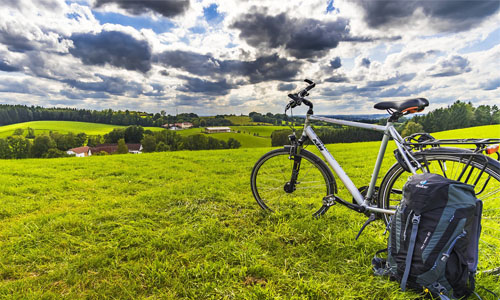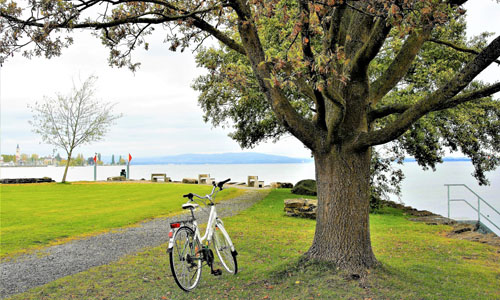Tips on How to Buy a Mountain Bike
Author

Chris shares his passion for cycling, hiking, skiing, and climbing from Buxton, in the Peak District. As a blogger for Outdoor Look, Chris shares outdoor tips and indoor tricks to help you get the most out of your time spent outside. When he's not out adventuring he's making videos or trying to keep up with his 4-year-old son.
 Mountain biking is one sport that has evolved a lot with passing time. At present we have access to some of the best and most advanced bikes, that have incredible features and are built for various riding styles. While buying one of these, one needs to consider a lot of factors in order to ensure that whatever you bike you invest in is worth spending your hard earned money on. Having knowledge about your personal riding skills is as important as knowing how flat the trail you wish to rid on will be. You'll need to get through a lot of contemplation and research before you get your hands on any particular bike.
Mountain biking is one sport that has evolved a lot with passing time. At present we have access to some of the best and most advanced bikes, that have incredible features and are built for various riding styles. While buying one of these, one needs to consider a lot of factors in order to ensure that whatever you bike you invest in is worth spending your hard earned money on. Having knowledge about your personal riding skills is as important as knowing how flat the trail you wish to rid on will be. You'll need to get through a lot of contemplation and research before you get your hands on any particular bike.
There are four basic mountain bikes that are easily available. These are:
- Cross Country (XC)
- Trail
- All Mountain (Enduro)
- Downhill (DH)
These are available in both carbon fibre and aluminum construction. It gets a little confusing when you have myriads of models, prices, and types of mountain bikes in front of you. The process becomes more like that of buying a car. It becomes mandatory to take your precious time and choose the one bike that suits your body and doesn't inhibit your riding abilities. Don’t just buy any random bike and risk wasting your money. Follow a few of these basic rules, which will steer you towards making the right purchasing decision for your new bike.
Style and Size
Don't just run into a shop and buy the first appealing bike that catches your eye. Finding the right bike should be at the top of your agenda. Also, what is perhaps most important is getting a bike in the right size. A bike that has the option of adjustable seats and crank arm is the best to opt for. Most of the bike stores will provide you with a bike that is compatible to your measurement.
Always follow the bike guide, if you are one those who are into following the online purchasing trend. However, one always has the option of getting their bikes serviced by a professional at an affordable price. I had even gone for a test riding session. Do that if that satisfies you too!
Remember, if you are one for whom pedal performance is top priority, then invest in Cross Country (XC). These are designed for uphill riding riders. Trail bikes are the second category of great climbers, as these bikes provide equally efficient performance irrespective of whether you are ascending or descending. Then you have the "Enduro", apt for technical downhill riding sessions.
Establish a Budget
Nowadays mountain bikes cost a huge amount of money. Even though these bikes are super cool in construction, there is no need to spend lavishly on them. I have especially avoided full suspension bikes as these cost a lot of money.
 Set your budget right and know more about the bikes that fall within that price range. This way you will not be swayed away by anyone who will impel you to spend more. It is always a good thing to stick to the brands that you have good knowledge of. One can opt for full suspension only and only when their budget is more than £1,000.
Set your budget right and know more about the bikes that fall within that price range. This way you will not be swayed away by anyone who will impel you to spend more. It is always a good thing to stick to the brands that you have good knowledge of. One can opt for full suspension only and only when their budget is more than £1,000.
To fix a budget also gets tricky when you have accessories in mind. It is obvious that once you buy a bike, you will invariably spend a little on the gear, gloves, helmets, etc. Hence, the crux of the matter is that if you are willing to buy an expensive bike, then do take into consideration the specs and durability of the same.
Biking Gear and the Game of Tires
Why leave behind the most important aspect while buying a mountain bike: Gear, accessories, and tires. Depending on the terrain, one might have to look for specific bike tires. Appropriate tires help in providing enhanced grip and traction. There are slick tires and "fat" tires too for optimum comfort on all kinds of terrain, be it snow, mud, sand, rough paths etc.
Owning a sturdy helmet, a sipper, a durable seat cover, lighting, etc. can be included in the must-have list. I have modified my bike according to my needs. With a sturdy aluminum handlebar and stylish mudguard and fencers, I have done a lot of experimentation with my bike. Also, I prefer wearing comfortable biking jackets and proper biking shoes while going on biking expeditions.
Author

Chris shares his passion for cycling, hiking, skiing, and climbing from Buxton, in the Peak District. As a blogger for Outdoor Look, Chris shares outdoor tips and indoor tricks to help you get the most out of your time spent outside. When he's not out adventuring he's making videos or trying to keep up with his 4-year-old son.
- Speed Up Your Post-Hike Recovery with These 6 Essential Tips
- Cycling through Tranquil Roads and Coastal Views on the Isle of Wight
- The Essential Guide to Hiking Safety: 5 Tips Every Hiker Should Know
- Run Smart, Run Strong: Your Guide to Injury-Free Running
- Embrace Biking: Essential Tips for Beginners
Categories
- Sport (28)
- Product Reviews (3)
- Team Outdoor Look (7)
- Mike Wild (2)
- Mike Payton (2)
- Suse Hammond-Pears (3)
- Snowboarding (12)
- Latest Offers (105)
- Shop Talk (1)
- Competitions (7)
- Walking (413)
- Lifestyle Fashion (8)
- Travel (86)
- Kit Guides (176)
- Workwear Clothing (6)
- Safety Workwear (4)
- Health/Fitness (289)
- Skiing (91)
- Great Outdoors (1316)
- Cycling (92)
- January 2025
- December 2024
- November 2024
- October 2024
- September 2024
- August 2024
- July 2024
- June 2024
- May 2024
- April 2024
- March 2024
- February 2024
- January 2024
- December 2023
- November 2023
- October 2023
- September 2023
- August 2023
- July 2023
- June 2023
- May 2023
- April 2023
- March 2023
- February 2023
- January 2023
- December 2022
- November 2022
- October 2022
- September 2022
- August 2022
- July 2022
- June 2022
- May 2022
- April 2022
- March 2022
- February 2022
- January 2022
- December 2021
- November 2021
- October 2021
- September 2021
- August 2021
- July 2021
- June 2021
- May 2021
- April 2021
- March 2021
- February 2021
- January 2021
- December 2020
- November 2020
- October 2020
- September 2020
- August 2020
- July 2020
- June 2020
- May 2020
- April 2020
- March 2020
- February 2020
- January 2020
- December 2019
- November 2019
- October 2019
- September 2019
- August 2019
- July 2019
- June 2019
- May 2019
- April 2019
- March 2019
- February 2019
- January 2019
- December 2018
- November 2018
- October 2018
- September 2018
- August 2018
- July 2018
- June 2018
- May 2018
- April 2018
- March 2018
- February 2018
- January 2018
- December 2017
- November 2017
- October 2017
- September 2017
- August 2017
- July 2017
- June 2017
- May 2017
- April 2017
- March 2017
- February 2017
- January 2017
- December 2016
- November 2016
- October 2016
- September 2016
- August 2016
- July 2016
- June 2016
- May 2016
- April 2016
- March 2016
- February 2016
- January 2016
- December 2015
- November 2015
- October 2015
- September 2015
- August 2015
- July 2015
- June 2015
- May 2015
- April 2015
- March 2015
- February 2015
- January 2015
- December 2014
- November 2014
- October 2014
- September 2014
- August 2014
- July 2014
- June 2014
- May 2014
- April 2014
- March 2014
- February 2014
- January 2014
- December 2013
- November 2013
- October 2013
- September 2013
- August 2013
- July 2013
- June 2013
- May 2013
- April 2013
- March 2013
- February 2013
- January 2013
- December 2012
- November 2012
- October 2012
- September 2012
- August 2012
- July 2012
- June 2012
- May 2012
- April 2012
- March 2012
- February 2012
- January 2012
- December 2011
- November 2011
- October 2011
- September 2011
- August 2011
- May 2010
- April 2010
- March 2010
- February 2010
- January 2010
- November 2009
- October 2009
- September 2009
Submit a Comment